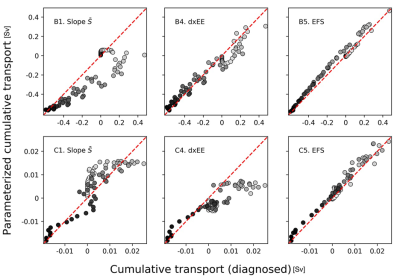Baroclinic Control of Southern Ocean Eddy Upwelling Near Topography
We use an idealized model of an ocean jet to examine how bottom topography along the Antarctic Circumpolar Current can enhance and localize eddy-induced upwelling. We find that the upwelling systematically occurs in regions where eddies grow through baroclinic instability, rather than in regions where eddy energy is large. We propose a simple parameterization of eddy-induced upwelling based on the zonal evolution of eddy energy, which provides a better representation of the zonal variability of upwelling around topography compared with existing parameterizations.
The upwelling that occurs in the Southern Ocean is an essential part of the global heat and carbon cycle, and ocean models rely on eddy parameterizations to represent these. Future ocean eddy parameterizations should consider metrics specific to the growth of baroclinic instability to accurately model eddy upwelling near topography.
The Southern Ocean plays an essential role in redistributing heat, salt, and biogeochemical tracers of importance in the climate system. In particular, locations in which strong ocean currents interact with large topographic features are hotspots for eddy-driven upward transport and are crucial pathways to bring deep, carbon- and nutrient-rich waters to the surface. The processes that set the location and magnitude of this eddy “upwelling” remain challenging to understand. This study uses a series of high-resolution idealized simulations in which an ocean jet encounters a piece of topography to investigate what controls the eddy upwelling near topography. We find that the upwelling due to eddies occurs in regions where the eddies are growing through a mechanism called “baroclinic instability,” rather than in regions where eddies are highly energetic or energized by other mechanisms. Regions of growing eddy energy are a simple, first-order indicator of regions of eddy upwelling, but future parameterizations of transport should consider the mechanism of instability to be more accurate.

